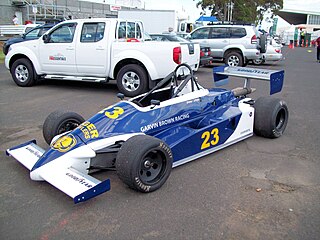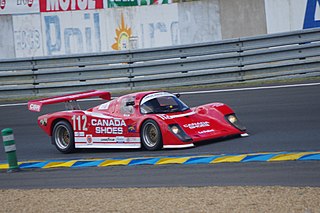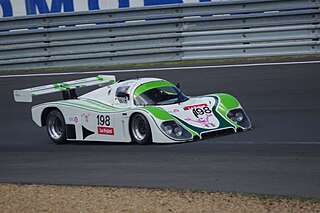
A Le Mans Prototype (LMP) is a type of sports prototype race car used in various races and championships, including the 24 Hours of Le Mans, FIA World Endurance Championship, IMSA SportsCar Championship, European Le Mans Series and Asian Le Mans Series. Le Mans Prototypes were created by the Automobile Club de l'Ouest (ACO). The technical requirements for an LMP include bodywork covering all mechanical elements of the car. As of 2023, there are two classes within Le Mans Prototypes, designated LMP2 and LMP3.

Group C was a category of sports car racing introduced by the FIA in 1982 and continuing until 1993, with Group A for touring cars and Group B for GTs.

Spice Engineering was a British racing team founded by driver Gordon Spice with Raymond Bellm in the early 1980s, later becoming a successful sports car constructor in 1986. They competed in the World Sportscar Championship in Europe as well as the IMSA GT Championship in North America, at times partnering with major manufacturers such as General Motors and Honda as well as race engine manufacturer Comptech.

The Lancia LC2 was a series of racing cars built by Italian automobile manufacturer Lancia and powered by engines built by their sister company Ferrari. They were part of Lancia's official factory-backed effort in the World Sportscar Championship from 1983 to 1986, although they continued to be used by privateer teams until 1991. They were also the company's first car meeting the FIA's new Group C regulations for sports prototypes.

The 1984 Sandown 1000 was an endurance motor race staged at the Sandown Raceway in Victoria, Australia on 2 December 1984. It was the eleventh and final round of the 1984 FIA World Endurance Championship and was the first FIA World Championship race to be held in Australia. It was to be the first of a three-year contract to race at Sandown, though the final two years would be cancelled.

Tiga Race Cars Ltd. was a British auto racing constructor and team. The company was founded in 1974 by two former Formula 1 drivers, Australian Tim Schenken and New Zealander Howden Ganley. The company's name was formed by the first two letters of Tim and Ganley. Tiga constructed racing cars for various forms of open wheel racing and sports car racing, ranging from Formula Ford to the World Sportscar Championship.
Embassy Racing was a British auto racing team founded by Jonathan France in 2003. Initially created as a conjunction with Xero Competition in the British GT Championship, the team expanded to become an independent team and began to win races in British GT before the team took a sabbatical year in 2006. Upon their return to motorsport, Embassy moved to the international Le Mans Series, running in a Le Mans Prototype class, as well as entering the British Superbike Championship's junior leagues, the Supersport and Superstock Championships, running with the support of Triumph Motorcycles under the MAP Embassy Triumph banner.

The 1986 ADAC Kouros 1000 km Nürburgring was the seventh round of the 1986 World Sports-Prototype Championship. It took place at the Nürburgring, West Germany on August 24, 1986.
Sean Walker is a British former racing driver. He stopped racing in 2013. His father Ian Walker (1926–2008) was noted as the "Doyen of British Motorsport" was a driver, engineer and designer/modifier of race cars particularly Lotus. Ian Walker's cars were driven by famous drivers such as Jim Clark, Graham Hill and Peter Arundell.

John Bartlett is best known as a former WSCC race driver and team owner in the 1980's. He first started racing FF1600 cars in 1979 before moving into sports prototypes.
John Schneider is a former American sports car racing driver.
The Tiga GC84, also known as the Tiga GC284, is a sports prototype race car, designed, developed, and built by British manufacturer Tiga Race Cars, for sports car racing, conforming to the Group C1/C2 rules and regulations, in 1984.
The Dallara GC21 was a Le Mans Prototype built by Dallara for the Fuji Grand Champion Series, and based on one of the company's Formula Three cars. It was raced between 2002 and 2007, competing in the LMP2 class of the Japan Le Mans Challenge in the last two years of its usage. A GC21, entered by MYZ, won the LMP2 category of the Japan Le Mans Challenge in 2006.
The Lamborghini Countach QVX, occasionally referred to as the Lamborghini QVX, was a short-lived Group C sports racing car built in 1985. It was not built or designed by the Lamborghini factory, but instead used a Spice Engineering-built chassis and an engine derived from the Lamborghini Countach's V12. Lamborghini's British importer commissioned the car. Financial issues restricted it to one race, despite numerous entries in 1986 and a handful in 1987, but its one race showed the car had potential.
Chamberlain Engineering was an automotive engine builder turned auto racing team founded by racing driver Hugh Chamberlain in 1972. The team moved through the British national sports car championships before becoming a competitor in the World Sportscar Championship, eventually winning world titles in 1989 and 1992. Chamberlain went on to develop sports cars for Jaguar and Lotus in the 1990s before becoming a customer of the Chrysler Viper GTS-R program in the FIA GT Championship; the team later led MG's return to Le Mans in 2001. Chamberlain later merged with Gareth Evans to form Chamberlain-Synergy Motorsport to campaign TVRs in 2004 before moving to the European Le Mans Series where they won another championship in 2005. Chamberlain-Synergy left active motorsports in 2008, although Hugh Chamberlain continues to work as a manager and consultant with other teams in sports car racing.

The Tiga GC287 is a sports prototype race car, designed, developed, and built by British manufacturer Tiga Race Cars, for sports car racing, conforming to the Group C2 rules and regulations, in 1987.

The Tiga GC286 is a sports prototype race car, designed, developed, and built by British manufacturer Tiga Race Cars, for sports car racing, conforming to the Group C2 rules and regulations, in 1986.
The Tiga GC285, also known as the Tiga GC85, is a sports prototype race car, designed, developed, and built by British manufacturer Tiga Race Cars, for sports car racing, conforming to the Group C2 rules and regulations, in 1985.
The 'Tiga GC83 is a sports prototype race car, designed, developed, and built by British manufacturer Tiga Race Cars, for sports car racing, conforming to the Group C1/C2 rules and regulations, in 1983.

The Tiga GC289 is a sports prototype race car, designed, developed, and built by British manufacturer Tiga Race Cars, for sports car racing, conforming to the Group C2/IMSA GTP Lights rules and regulations, in 1989.











